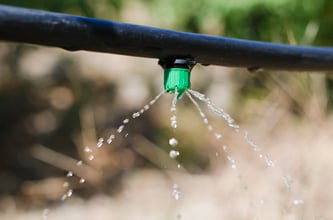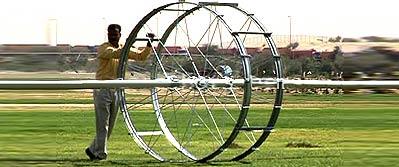Human beings have used irrigation as a means to feed large populations for more than two millennia. However, not all types are suitable in every case, meaning that farmers must choose the right system for each specific application. Two widely used options around the world to consider are drip irrigation and sprinkler irrigation.
In this article, we examine the difference between these popular choices to offer some clarity on the subject. Here we look at each type of system, comparing the pros and cons so that you can make the best, informed decision for your needs.
Drip Irrigation & How it Works

Drip irrigation supplies water to crop roots slowly, drop by drop. Farmers use the technique to supply low-pressure H2O through plastic tubing, with emitters used to regulate the flow rate.
The tubing is typically placed beneath the soil's surface or simply on the ground.
The equipment used in drip irrigation typically features water pumps, drippers, filters, injectors, micro flappers (drippers), pressure-compensating drip lines, sand separators, fertigation systems, chemigation equipment, and backwash controllers.
The Pros of Drip Irrigation include:
●Evaporation is minimized, saving your operation precious water
●Drip irrigation reduces leaching, helping the soil to retain nutrients
●No land grading (surface leveling) is required
●It's suitable for irregular-shaped fields
The Cons of Drip Irrigation include:
●Clogging can occur when using water with a high iron content
●Rodents & insects can cause leaks by chewing
●Requires regular monitoring and maintenance
●Equipment can sometimes slice drip irrigation tubing
Almost any crop, from sugar cane to soybeans, can be grown using the drip irrigation method, making it one of the most useful options available to farmers. However, how does it compare to sprinkler systems?
Sprinkler Irrigation & The Equipment Used
Employed widely across agriculture, sprinkler irrigation simulates rainfall, distributing water and spraying it into the air. This causes it to break up into small water drops and drop down onto the ground, as would happen naturally.
Typically used in sprinkler irrigation, you'll find misters, spray stakes, sprinklers,
polyethylene pipes, aluminum pipes & fittings, and drip lines.
The pros of sprinkler irrigation include:
●Automated center pivot systems can be programmed to stop/start at certain times
●Chemigation & fertigation can be used to control pests
●Water can be delivered at extremely low rates
●Great for medium/coarse-textured soil
The cons of sprinkler irrigation include:
●Low-quality water can clog sprinkler nozzles
●Frequent recharging of depleted soil is required
●Deep tire ruts can appear on clay soils
●Crops may become scalded
Suitable for most tree, field, and row crops, sprinkler systems can be sprayed directly or under the canopy. However, when dealing with delicate crops, the large water droplets emitted may damage the crops.
Talk to the Irriline Team About Your Requirements

The most suitable irrigation option for your needs will depend very much on the type of crops you're growing and the land being used. As such, you may need expert guidance, and the Irrline team is here to give you the assistance and high-quality equipment you need. We manufacture and distribute a broad range of reliable irrigation equipment around the world from our headquarters in Vancouver, BC.
Our team is committed to meeting every customer need with our reliable die-cast aluminum tubing & fittings, sprinklers and drip irrigation systems designed to excel in the most challenging of environments. To find out more about how our irrigation systems can help you, give us a call on +1604 6084315 or email us at irrilinecanada@irriline.com
